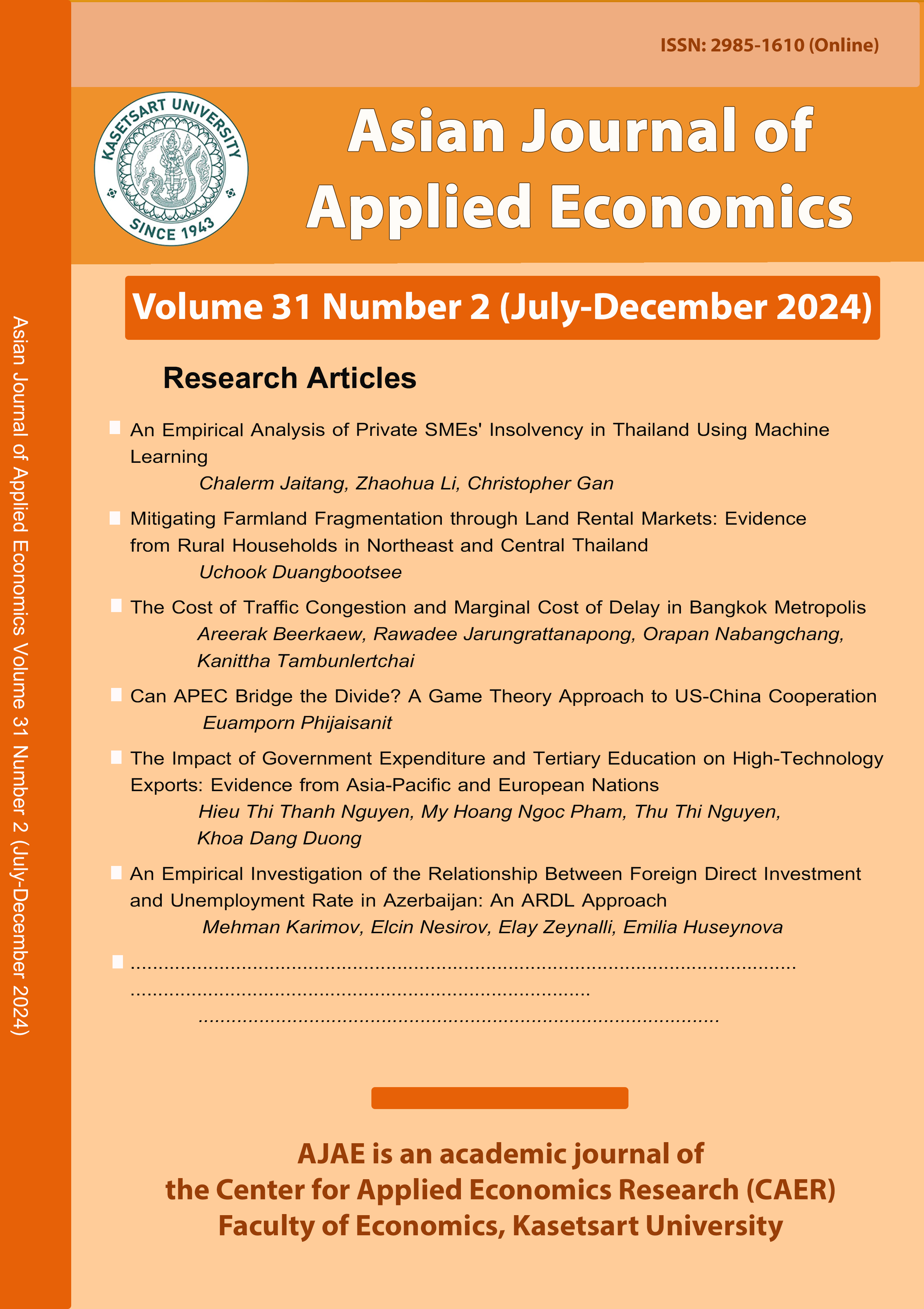An Empirical Analysis of Private SMEs' Insolvency in Thailand Using Machine Learning
Main Article Content
Abstract
We investigate the insolvency of private Thai SMEs in the manufacturing, trading, and service sectors from 2017 to 2021. We model insolvency as a function of industry-relative financial ratios, firm characteristics, and local economic conditions using Least Absolute Shrinkage and Selection Operator (LASSO) logistic regression. The analysis shows the significant influence of financial ratios on the probability of insolvency for all sectors, particularly inventory turnover, accounts payable turnover, assets to equity, and debt to assets ratio. The service sector shows a unique positive effect of working capital to total assets on insolvency risk, implying that firms with high current assets or very low current liabilities are more prone to insolvency. Medium-sized firms, those registered as juristic ordinary partnerships, owned by foreigners, and located in less competitive areas are less likely to face insolvency.
Article Details

This work is licensed under a Creative Commons Attribution-NonCommercial-NoDerivatives 4.0 International License.
The paper is published under CC BY-NC-ND, in which the article is freely downloaded and shared in its original form non-commercially and its citation details are identified.
References
Aho, K., Derryberry, D., & Peterson, T. (2014). Model selection for ecologists: The worldviews of AIC and BIC. Ecology, 95(3), 631–636.
Altman, E. I. (1968). Financial ratio, discriminant analysis and the prediction of corporate bankruptcy. The Journal of Finance, 23(4), 589–609.
Altman, E. I., Iwanicz‐Drozdowska, M., Laitinen, E. K., & Suvas, A. (2017). Financial distress prediction in an international context: A review and empirical analysis of Altman’s Z‐ score model. Journal of International Financial Management & Accounting, 28(2), 131–171.
Beaver, W. H., Correia, M., & McNichols, M. F. (2012). Do differences in financial reporting attributes impair the predictive ability of financial ratios for bankruptcy? Review of Accounting Studies, 17(4), 969–1010.
Camacho-Miñano, M. del M., Segovia-Vargas, M.J., & Pascual-Ezama, D. (2015). Which characteristics predict the survival of insolvent firms? An SME reorganization prediction model. Journal of Small Business Management, 53(2), 340–354.
Fuertes-Callén, Y., Cuellar-Fernández, B., & Serrano-Cinca, C. (2022). Predicting startup survival using first years financial statements. Journal of Small Business Management, 60(6), 1314–1350.
Gupta, J., Gregoriou, A., & Ebrahimi, T. (2018). Empirical comparison of hazard models in predicting SMEs failure. Quantitative Finance, 18(3), 437–466.
Hanley, J. A., & McNeil, B. J. (1982). The meaning and use of the area under a receiver operating characteristic (ROC) curve. Radiology, 143(1), 29–36.
Hastie, T., Tibshirani, R., & Friedman, J. (2009). The elements of statistical learning: Data mining, inference, and prediction (2nd ed.). New York: Springer.
Hernandez Tinoco, M., Holmes, P., & Wilson, N. (2018). Polytomous response financial distress models: The role of accounting, market and macroeconomic variables. International Review of Financial Analysis, 59, 276–289.
Hernandez Tinoco, M., & Wilson, N. (2013). Financial distress and bankruptcy prediction among listed companies using accounting, market and macroeconomic variables. International Review of Financial Analysis, 30, 394–419.
Inekwe, J. N. (2016). Financial distress, employees’ welfare and entrepreneurship among SMEs. Social Indicators Research, 129(3), 1135–1153.
Islam, M. S., Semeen, H., & Farah, N. (2013). The effects of financial ratios on bankruptcy. Independent Business Review, 6(2), 52–67.
Li, K. (2024). Liquidity ratios and corporate failures. Accounting & Finance, 64(1), 1111–1134.
Lizares, R. M., & Bautista, C. C. (2021). Corporate financial distress: The case of publicly listed firms in an emerging market economy. Journal of International Financial Management & Accounting, 32(1), 5–20.
Malakauskas, A., & Lakstutiene, A. (2021). Financial distress prediction for small and medium enterprises using machine learning techniques. Inžinerinė Ekonomika-Engineering Economics, 32(1), 4–14.
Mrockova, N. (2022). Resolving SME insolvencies: An analysis of new Chinese rules. Journal of Corporate Law Studies, 22(1), 469–503.
Muñoz‐Izquierdo, N., Laitinen, E. K., Camacho‐Miñano, M. del M., & Pascual‐Ezama, D. (2020). Does audit report information improve financial distress prediction over Altman’s traditional Z ‐score model? Journal of International Financial Management & Accounting, 31(1), 65–97.
Patel, P. C., Guedes, M. J., & Pearce, J. A. (2017). The role of service operations management in new retail venture survival. Journal of Retailing, 93(2), 241–251.
Pissarides, F., Singer, M., & Svejnar, J. (2003). Objectives and constraints of entrepreneurs: Evidence from small and medium size enterprises in Russia and Bulgaria. Journal of Comparative Economics, 31(3), 503–531.
Platt, H. D., & Platt, M. B. (1990). Development of a class of stable predictive variables: The case of bankruptcy prediction. Journal of Business Finance & Accounting, 17(1), 31–51.
StataCorp LLC. (2021). Stata Lasso reference manual release 17. College Station, TX: Stata Press.
The Office of Small and Medium Enterprises Promotion (OSMEP). (2021). SME Transformation (Annual report 2021). Bangkok, Thailand: OSMEP.
Tian, S., & Yu, Y. (2017). Financial ratios and bankruptcy predictions: An international evidence. International Review of Economics & Finance, 51, 510–526.
Tian, S., Yu, Y., & Guo, H. (2015). Variable selection and corporate bankruptcy forecasts. Journal of Banking & Finance, 52, 89–100.
Tibshirani, R. (1996). Regression shrinkage and selection via the Lasso. Journal of the Royal Statistical Society: Series B (Methodological), 58(1), 267–288.
Tong, Y., & Serrasqueiro, Z. (2021). Predictions of failure and financial distress: A study on Portuguese high and medium-high technology small and mid-sized enterprises. Journal of International Studies, 14(2), 9–25.
World Bank Group. (2017). Report on the treatment of MSME insolvency (Report No. 114823). Washington, D.C: World Bank Group.
Xiao, Z., Yang, X., Pang, Y., & Dang, X. (2012). The prediction for listed companies’ financial distress by using multiple prediction methods with rough set and Dempster-Shafer evidence theory. Knowledge-Based Systems, 26, 196–206.
Yoshino, N., & Taghizadeh-Hesary, F. (2016). Major challenges facing small and medium-sized enterprises in Asia and solutions for mitigating them (ADBI Working Paper No.564). Tokyo: Asian Development Bank Institute.


